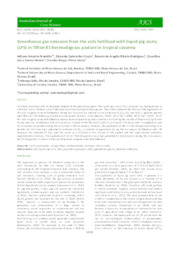Greenhouse gas emission from the soils fertilized with liquid pig slurry (LPS) in Tifton 85 bermudagrass pasture in tropical savanna.
Greenhouse gas emission from the soils fertilized with liquid pig slurry (LPS) in Tifton 85 bermudagrass pasture in tropical savanna.
Author(s): BRANDÃO, A. A.; COUTO, E. G.; RODRIGUES, R. de A. R.; WEBER, O. L. S.; PINTO JÚNIOR, O. B.
Summary: Soils have important roles in the global budgets of the greenhouse gases. The liquid pig slurry (LPS) in pastures has high potential as a fertilizer but could have a direct influence on emission of greenhouse gasses. This study evaluated the effects of the application of LPS and inorganic mineral fertilization during the rainy and dry seasons on the emissions of CO2, CH4 and N2O in pastures planted with Tifton-85. The following treatments were tested: Control - no fertilization; LPS30 - 30 m3 ha-1; LPS60 - 60 m3 ha-1; LPS90 - 90 m3 ha-1 and inorganic mineral fertilization. Gasses were sampled using static chambers first during the months of March and April, then in June and July. Fertilization with LPS caused an increase in the flux of CO2 and CH4 during the first hours after its application, and CO2 emissions are greater during the rainy than in the dry season. However, the application of LPS in Tifton-85 pasture during rainy periods did not show high potential for emission of CO2, in contrast to application during the dry season. Fertilization with LPS increases the emission of N2O, and this varies as a function of the volume of LPS applied and the experimental conditions experimental conditions. The application of LPS in Tifton-85 pasture has a high potential for N2O emission during the rainy season, but the magnitude is similar to that resulting from inorganic mineral fertilization.
Publication year: 2020
Types of publication: Journal article
Unit: Embrapa Soils
Observation
Some of Embrapa's publications are published as ePub files. To read them, use or download one of the following free software options to your computer or mobile device. Android: Google Play Books; IOS: iBooks; Windows and Linux: Calibre.
Access other publications
Access the Agricultural Research Database (BDPA) to consult Embrapa's full library collection and records.
Visit Embrapa Bookstore to purchase books and other publications sold by Embrapa.

